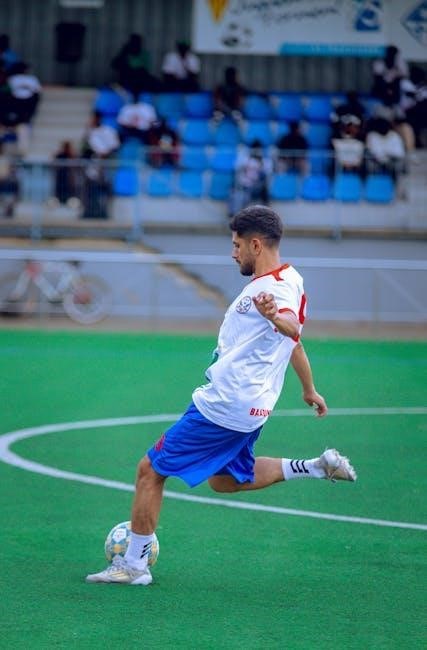Soccer conditioning programs are designed to enhance player performance, endurance, and agility while reducing injury risk․ These structured plans combine strength, cardio, and flexibility exercises tailored to individual needs․

1․1 Importance of Conditioning in Soccer

Soccer conditioning is crucial for optimal performance, injury prevention, and longevity in the sport․ A well-structured program enhances endurance, strength, and agility, enabling players to meet the demands of the game․ Conditioning ensures athletes can maintain high-intensity efforts over 90 minutes, recover efficiently, and adapt to varying match scenarios․ It also builds mental resilience, critical for overcoming fatigue and staying focused during competitions․ Off-season conditioning lays a foundational fitness base, while in-season programs maintain and refine physical capabilities․ Proper conditioning reduces injury risk by strengthening muscles and improving flexibility․ Coaches and trainers emphasize its importance, as it directly impacts team success and player sustainability․ Conditioning is the backbone of modern soccer, separating good players from elite athletes․
1․2 Overview of a Soccer Conditioning Program
A soccer conditioning program is a structured plan designed to improve physical fitness, enhance performance, and reduce injury risk․ It typically includes phases like off-season preparation, pre-season intensity, and in-season maintenance․ Key components involve strength training, cardiovascular exercises, agility drills, and flexibility routines․ Programs often incorporate periodization, alternating between high-intensity and recovery periods․ Nutrition and recovery strategies are also emphasized to optimize results․ The program is tailored to individual needs, ensuring players build a strong foundation, increase stamina, and peak at the right time․ Proper planning and execution ensure athletes are prepared for the demands of the game, fostering long-term success and sustainability in their soccer careers․
The Science Behind Soccer Conditioning
Soccer conditioning is rooted in exercise physiology, focusing on enhancing endurance, strength, and agility․ It applies periodization to optimize performance, ensuring players peak during the season․
2․1 Physiology of Soccer Performance
The physiology of soccer performance revolves around the body’s ability to sustain high-intensity efforts over 90 minutes․ Players rely heavily on both aerobic and anaerobic energy systems․ Aerobic endurance provides sustained energy, while anaerobic systems deliver short bursts of power․ Muscular strength and power are crucial for sprinting, jumping, and quick changes of direction․ Additionally, core stability and flexibility enhance movement efficiency and reduce injury risk․ Understanding these physiological demands allows coaches to design conditioning programs that address specific needs, ensuring optimal performance during matches․ Proper conditioning also improves recovery, enabling players to maintain consistent levels of intensity throughout the season․ This holistic approach ensures peak physical readiness․
2․2 Periodization in Soccer Training
Periodization in soccer training involves structuring workouts into specific cycles to optimize performance and prevent overtraining․ The season is divided into macro, meso, and micro cycles, each with distinct goals․ The off-season focuses on building foundational strength and endurance, while the pre-season shifts to high-intensity drills and match-specific scenarios․ This structured approach ensures players peak during the competitive season․ By alternating intense training phases with recovery periods, periodization enhances adaptability and reduces injury risks․ Coaches tailor these cycles to address positional demands and team strategies, ensuring a balanced and progressive development of skills and fitness․ Proper periodization is essential for maintaining player readiness and achieving long-term success․

Key Components of a Soccer Conditioning Program
A well-rounded soccer conditioning program includes strength training, endurance, agility drills, flexibility exercises, proper nutrition, and recovery strategies to enhance performance and prevent injuries․
3․1 Strength Training for Soccer
Strength training is crucial for soccer players to build muscle, enhance power, and improve overall performance․ It focuses on exercises like squats, lunges, and leg presses to strengthen the lower body․ Core exercises, such as leg raises and Russian twists, are essential for stability and balance․ Weight lifting programs often include cycles targeting endurance, power, and strength․ Proper form and progression are key to avoiding injuries․ Strength training also enhances explosive movements, allowing players to sprint faster and jump higher․ A well-structured program ensures players can withstand the physical demands of the game, making them more competitive and resilient during matches․
3․2 Endurance and Cardiovascular Fitness
Endurance and cardiovascular fitness are vital for soccer players to maintain stamina throughout the game․ These workouts improve heart health and increase energy levels․ Activities like jogging, cycling, and high-intensity interval training (HIIT) are commonly used․ During the off-season, players focus on building a base level of fitness to prepare for the upcoming season․ Consistent cardio exercises help players recover faster between plays․ Incorporating endurance training ensures players can perform at their best over the full 90 minutes, making it a cornerstone of any soccer conditioning program․ A strong cardiovascular system is essential for prolonged effort and quick recovery, giving players a competitive edge․ Regular endurance training also reduces the risk of fatigue-related injuries, keeping players healthy and performant; Teams that prioritize cardiovascular fitness often see improved overall performance and cohesion on the field․ This aspect of conditioning is non-negotiable for aspiring professional soccer athletes aiming to meet the demands of the sport․ The combination of endurance and strength training creates a well-rounded athlete capable of excelling in various game scenarios․ Over time, consistent endurance workouts translate to better speed, agility, and the ability to maintain a high-intensity effort throughout the match․ As a result, endurance training remains a fundamental component of all successful soccer conditioning programs․ Players who commit to regular cardio exercises not only enhance their physical capabilities but also develop the mental toughness needed to push through challenging moments during games․ The integration of endurance and cardiovascular fitness into a training regimen is essential for achieving peak performance and ensuring long-term success in soccer․ By focusing on these elements, players can build the stamina and resilience required to compete at higher levels and contribute effectively to their team’s success․ In summary, endurance and cardiovascular fitness are indispensable for soccer players, providing the foundation needed to excel in this demanding sport․
3․3 Agility and Speed Drills

Agility and speed drills are crucial for enhancing a soccer player’s ability to quickly change direction, accelerate, and decelerate․ These exercises improve reaction time and coordination, essential for outperforming opponents on the field․ Common drills include cone exercises, ladder drills, and shuttle runs, which focus on sharp, explosive movements․ Incorporating plyometric exercises like box jumps and burpees can also boost explosive power․ Agility drills mimic game scenarios, preparing players for rapid changes in direction․ Speed training often involves sprinting exercises and resisted runs to build acceleration and endurance․ These drills not only improve physical performance but also enhance mental focus and adaptability, making them indispensable for soccer conditioning programs․ Proper execution ensures players can maintain top speed while maintaining control, a critical skill in competitive soccer․
3․4 Flexibility and Mobility Exercises
Flexibility and mobility exercises are essential for maintaining a full range of motion and preventing injuries in soccer․ These exercises target major muscle groups like hamstrings, quadriceps, and hip flexors, often tight from repetitive kicking and sprinting․ Dynamic stretches, such as leg swings and lunges, improve flexibility while preparing muscles for activity․ Mobility drills, like hip circles and ankle rotations, enhance joint movement and reduce stiffness․ Incorporating yoga or Pilates can further improve flexibility and balance․ Proper warm-up and cool-down routines ensure muscles are adequately prepared and recovered, lowering the risk of strains and pulls․ Regular flexibility training also enhances overall performance by allowing for more powerful movements and better coordination on the field․ Consistency is key to maintaining optimal flexibility and mobility for soccer players․
3․5 Nutrition and Recovery Strategies
Nutrition and recovery are critical components of a soccer conditioning program, ensuring players perform optimally and recover effectively․ A balanced diet rich in proteins, carbohydrates, and healthy fats fuels energy needs and supports muscle repair․ Proper hydration is essential for performance and recovery, with players encouraged to drink water regularly․ Post-workout recovery strategies, such as protein shakes and carbohydrate intake, help replenish energy stores and rebuild muscles․ Additionally, techniques like foam rolling, ice baths, and stretching aid in reducing muscle soreness and improving flexibility․ Adequate sleep is vital for overall recovery, with 7-9 hours recommended for athletes․ A well-planned nutrition and recovery plan enhances performance, prevents fatigue, and supports long-term player health․ Consistency in these practices ensures players maintain peak physical condition throughout the season․

Sample 6-Week Soccer Conditioning Program
A 6-week soccer conditioning program is designed to progressively build fitness, starting with foundational endurance and strength, then advancing to intensity and pre-season preparation․ Each phase focuses on specific skills like agility, speed, and power, ensuring players are game-ready by week six․ The program includes structured workouts, drills, and recovery strategies to maximize performance and minimize injury risks․ Consistency and adherence to the program are key for achieving optimal results․

4․1 Week 1-2: Building a Foundation
The first two weeks of a soccer conditioning program focus on establishing a solid fitness base․ Players engage in low-intensity endurance exercises, such as steady-state runs and high-volume drills, to improve cardiovascular health․ Strength training introduces foundational exercises like squats, lunges, and core workouts to build muscular endurance․ Mobility and flexibility exercises, including dynamic stretching and yoga, are incorporated to enhance range of motion and prevent stiffness․ Agility drills, such as cone exercises and shuttle runs, are introduced at a moderate intensity to improve coordination․ Recovery strategies, including rest days and proper nutrition, are emphasized to ensure players adapt to the demands of the program․ This phase sets the stage for more intense training in subsequent weeks․
4․2 Week 3-4: Increasing Intensity
During weeks 3 and 4, the conditioning program shifts to increasing intensity, focusing on building both aerobic capacity and muscular strength․ High-Intensity Interval Training (HIIT) is introduced, with short bursts of sprinting followed by brief recovery periods․ Strength training progresses to more power-oriented exercises, such as plyometrics and box jumps, to enhance explosiveness․ Speed and agility drills become more dynamic, incorporating zigzag runs and shuttle sprints to mimic match scenarios․ Endurance workouts transition from steady-state runs to interval-based sessions, improving anaerobic endurance․ Mobility exercises remain consistent but are tailored to address tightness from increased activity․ Recovery strategies are emphasized to prevent overtraining, including active recovery days with light swimming or cycling․ Nutrition advice is refined to optimize energy levels and support muscle repair during this intense phase․
4․3 Week 5-6: Pre-Season Preparation
Weeks 5 and 6 focus on simulating game scenarios to prepare players for the upcoming season․ Training sessions emphasize functional drills, small-sided games, and tactical exercises to enhance teamwork and decision-making․ High-intensity intervals are reduced, with a focus on maintaining stamina and explosive power․ Strength training shifts to dynamic exercises, such as resisted sprinting and plyometric drills, to improve acceleration and agility․ Recovery strategies are fine-tuned, with a focus on active recovery techniques like swimming or yoga to maintain flexibility and reduce muscle soreness․ Nutrition advice is tailored to optimize energy levels during matches, and players participate in live game-like situations to prepare mentally and physically for competition․

Advanced Conditioning Techniques
Advanced techniques include plyometrics for explosive power and HIIT for cardiovascular endurance, enhancing speed, agility, and overall performance in soccer players․
5․1 Plyometrics and Explosive Training
Plyometrics and explosive training are essential for improving power and speed in soccer․ These exercises, such as box jumps and burpees, focus on rapid, high-intensity movements to enhance acceleration and jumping ability․ By incorporating plyometric drills, players can develop the explosiveness needed for sprinting, shooting, and changing direction quickly on the field․ This type of training also strengthens the muscles used in dynamic movements, reducing the risk of injuries․ Plyometrics are often combined with other conditioning methods to create a well-rounded program․ Proper form and progression are crucial to maximize benefits and prevent overtraining․ Incorporating plyometric exercises into a soccer conditioning program can significantly improve a player’s overall performance and competitiveness․
5․2 High-Intensity Interval Training (HIIT)
High-Intensity Interval Training (HIIT) is a powerful component of soccer conditioning programs, designed to boost cardiovascular fitness, speed, and endurance․ HIIT involves short bursts of maximum effort followed by brief recovery periods, mimicking the demands of a soccer match․ This type of training improves anaerobic and aerobic capacity, enabling players to sustain high-intensity efforts over the game’s duration․ HIIT workouts, such as sprint intervals or hill climbs, are highly effective for enhancing agility and acceleration․ They also promote fat burning and muscular endurance, making them ideal for players seeking to improve overall fitness․ When incorporated into a conditioning program, HIIT sessions can be tailored to individual fitness levels, ensuring optimal results while minimizing the risk of overtraining․ Regular HIIT sessions can significantly enhance a player’s performance on the field․
Injury Prevention and Safety
Injury prevention is crucial in soccer conditioning, focusing on proper warm-ups, cool-downs, and strengthening exercises to reduce injury risks․ Safety measures ensure players train effectively without harm․
6․1 Warm-Up and Cool-Down Routines
Effective warm-ups and cool-downs are essential for injury prevention and performance․ Warm-ups increase blood flow and flexibility, preparing muscles for activity․ They typically include light cardio and dynamic stretches․ Cool-downs help gradually lower heart rates and reduce muscle tension, preventing soreness․ Incorporating exercises like jogging, leg swings, and calf raises during warm-ups, followed by static stretches and foam rolling during cool-downs, ensures a safe transition into and out of intense training․ These routines are vital for maintaining player health and optimizing recovery in soccer conditioning programs․ Consistency in these practices significantly reduces the risk of injuries and enhances overall athleticism․
6․2 Common Injuries and Prevention Strategies

Soccer players often experience injuries like hamstring strains, knee injuries (e․g․, ACL tears), and ankle sprains due to the sport’s high demands․ Prevention strategies include strengthening the muscles around the knees and ankles, improving flexibility through stretching, and enhancing balance and coordination․ Proper warm-ups, dynamic stretching, and incorporating injury-specific exercises can significantly reduce the risk of these injuries․ Additionally, wearing appropriate footwear and using supportive braces when necessary can provide extra protection․ Coaches and players should also focus on technique improvement to avoid awkward movements that may lead to injuries․ A well-structured conditioning program, including these strategies, helps maintain player health and longevity in the sport․
Measuring Progress and Adjusting the Program

Tracking fitness metrics like speed, endurance, and strength helps assess player progress․ Adjustments to the program are made based on performance, ensuring continuous improvement and optimal results․
7․1 Tracking Fitness Metrics
Tracking fitness metrics is essential to monitor progress in a soccer conditioning program․ Key metrics include endurance, strength, speed, agility, and cardiovascular health․ These are measured through specific tests such as 40-meter sprints for speed, bench presses for strength, and VO2 max tests for endurance․ Additionally, heart rate monitoring during workouts provides insights into cardiovascular fitness․ Regular assessments help identify areas needing improvement and ensure the program is tailored to individual needs․ By analyzing data over time, coaches can refine training strategies, preventing plateaus and enhancing overall performance․ This systematic approach ensures players achieve peak fitness levels, preparing them effectively for competition․ Consistent tracking fosters accountability and motivates athletes to push their limits․
7․2 Tailoring the Program for Individual Needs
Tailoring a soccer conditioning program to individual needs ensures optimal progress and prevents overtraining․ Each player’s goals, fitness level, and position-specific demands are considered․ For example, a forward may focus more on speed and agility, while a defender prioritizes strength and endurance․ Coaches assess player data, including fitness metrics, to create personalized routines․ This customization fosters better engagement and reduces injury risks․ Adjustments are made based on performance trends, allowing players to gradually increase intensity․ By addressing unique needs, the program maximizes efficiency, ensuring each athlete reaches their full potential․ Regular feedback and adaptability are crucial for maintaining a effective and dynamic training approach․ This personalized method enhances overall team performance and player satisfaction․
